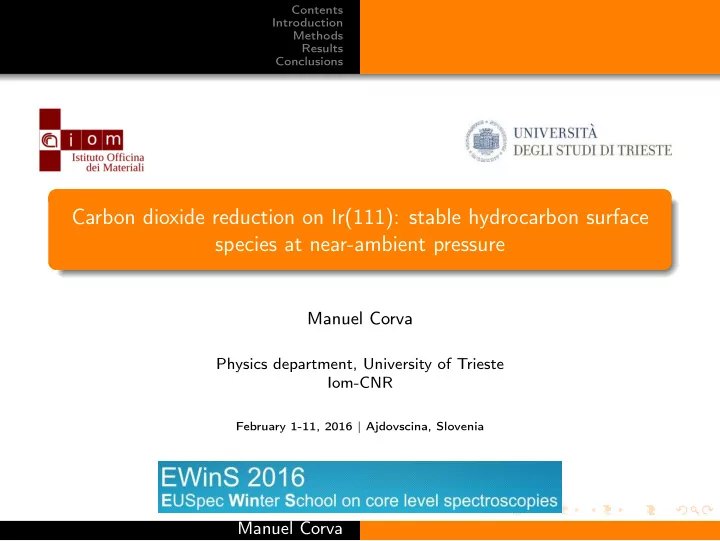

Contents Introduction Methods Results Conclusions Carbon dioxide reduction on Ir(111): stable hydrocarbon surface species at near-ambient pressure Manuel Corva Physics department, University of Trieste Iom-CNR February 1-11, 2016 | Ajdovscina, Slovenia Manuel Corva
Contents Introduction Methods Results Conclusions Introduction 1 Methods 2 Near-ambient pressure XPS Non-linear vibronic spectroscopy Results 3 Stable intermediates under reaction conditions Graphene seeding - aromatic compounds Conclusions 4 Manuel Corva
Contents Introduction Methods Results Conclusions CO 2 molecule CO 2 : MeOH: Industrial catalyst: Cu/ZnO/Al 2 O 3 Green house effect 50-100 bar Low price Stable: 8.3 eV 500-550 K Manuel Corva
Contents Introduction Methods Results Conclusions Catalytic CO 2 reduction in biology Acetogenic bacteria: Photosynthesis: Carbon fixation reaction on PS-II, Carbon fixation towards acetyl groups, Ca, Mn-containing cluster. Ni-containing cluster. Ferreira, K.N. et al. Science. 303 (2004) 1831 Ragsdale, S. W. Chem. Rev. 106 (2006) 3317–3337 Manuel Corva
Contents Introduction Methods Results Conclusions Ni(110) surface, CO+CO 2 +H 2 mixtures Highest interaction energy with CO 2 (0.6 eV); Surface conditions depend on reaction condition at NAP regimes! Monachino, E. et al. , J. Phys. Chem. Lett. 5 (2014) 1929–1934 Manuel Corva
Contents Introduction Methods Results Conclusions Ir(111) surface Why iridium? Target: Ethylene decomposition and CO 2 interactions with Ir; graphene growth; Adsorbed species under CO 2 reduction in reaction conditions. homogeneous catalysis. Manuel Corva
Contents Introduction Near-ambient pressure XPS Methods Non-linear vibronic spectroscopy Results Conclusions High pressure spectroscopies Manuel Corva
Contents Introduction Near-ambient pressure XPS Methods Non-linear vibronic spectroscopy Results Conclusions NAP-XPS spectroscopy: setup CAD model ISISS end station at Bessy2 (Berlin) Manuel Corva
Contents Introduction Near-ambient pressure XPS Methods Non-linear vibronic spectroscopy Results Conclusions IR-Vis SFG spectroscopy Visp-Lab, Physics Department, University of Trieste Manuel Corva
Contents Introduction Near-ambient pressure XPS Methods Non-linear vibronic spectroscopy Results Conclusions IR-Vis SFG spectroscopy: principle Non linear optics Lineshape: electronic and vibrational contributions. Symmetry imposes response only from interfaces! Manuel Corva
Contents Introduction Stable intermediates under reaction conditions Methods Graphene seeding - aromatic compounds Results Conclusions UHV thermal decomposition of ethylene C-H stretch region Ethylidyne (CCH 3 ): 2880, 2975 cm − 1 Ethynyl (CCH): 3002, 3023 cm − 1 Manuel Corva
Contents Introduction Stable intermediates under reaction conditions Methods Graphene seeding - aromatic compounds Results Conclusions CO 2 +CO+H 2 mixtures at 0.1 mbar C-H stretch region Partial pressure and T dependence Ethylidyne (2904, 2976 cm − 1 ) and ethynyl (3000, 3035 cm − 1 ) Aromatic hydrocarbons (3078 cm − 1 ) Manuel Corva
Contents Introduction Stable intermediates under reaction conditions Methods Graphene seeding - aromatic compounds Results Conclusions Graphenic domains Carbon core levels region Manuel Corva
Contents Introduction Methods Results Conclusions Conclusions Stable adsorbed species on the surface; Analogy between CO 2 reduction and ethylene decomposition; Aromatic fingerprints; Step by step dehydrogenation towards graphene. Manuel Corva
Contents Introduction Methods Results Conclusions Acknowledgements My supervisor: Erik Vesselli Financial support: Institutions: People: FIRB2010 CNR-IOM Feng, Zhijing; COST University of Dri, Carlo; University of Trieste, Physics Trieste, Physics Comelli, Giovanni; Department Department Manuel Corva
Contents Introduction Methods Results Conclusions Thank you for your attention! Manuel Corva
Contents Introduction Methods Results Conclusions CO adsorption and CO 2 decomposition Manuel Corva
Contents Introduction Methods Results Conclusions Line shape ∝ χ ( 2 ) P SFG i , j , k E ( ω IR ) j , k E ( ω Vis ) j , k i it is possible to define a χ eff : 2 � � A ( R ) e i ∆ φ k � A ( NR ) + � � � I SFG ( ω IR ) ∝ I Vis I IR ( ω IR ) k � � k ω k − i Γ k − ω IR � A ( R ) amplitude, ∆ φ k relative phase, ω k frequency, and Γ k linewidth k of the k-resonance. Manuel Corva
Recommend
More recommend